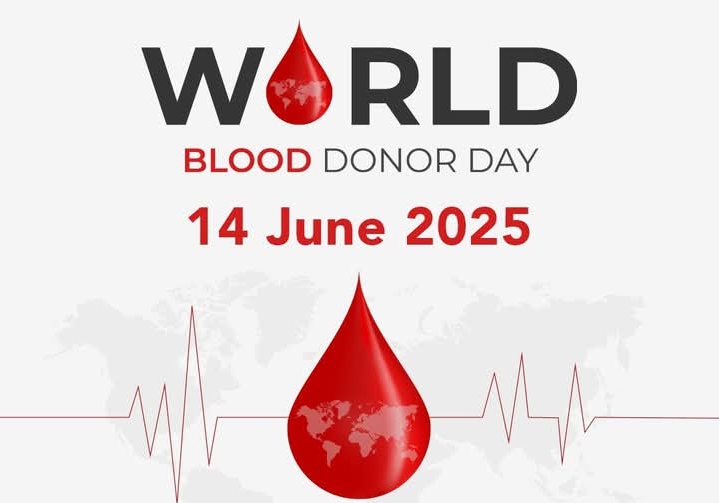World Blood Donor Day (WBDD) is observed annually on June 14 to honor the selfless contributions of voluntary, unpaid blood donors and to raise awareness about the critical need for safe blood and blood products. Established by the World Health Organization (WHO) in 2004, this day coincides with the birthday of Karl Landsteiner, the Austrian biologist who discovered the ABO blood group system, a breakthrough that revolutionized transfusion medicine .
The theme for World Blood Donor Day 2025 is “Give blood, give hope: together we save lives.” This slogan underscores the profound impact that blood donors have on saving lives, emphasizing the collective responsibility of communities to ensure a steady and safe blood supply
The Importance of Blood Donation:
Blood transfusions are essential for various medical treatments and emergencies. They are crucial for:
Women experiencing complications during pregnancy and childbirth: Severe bleeding during and after childbirth is a leading cause of maternal mortality worldwide.
Children suffering from severe anemia due to malaria or malnutrition: Anemia is prevalent in many developing countries, leading to fatigue, weakness, and increased susceptibility to infections.
Patients undergoing complex medical and surgical procedures: Surgeries such as organ transplants, cardiac surgeries, and cancer treatments often require significant blood transfusions.
Individuals with blood disorders like sickle cell disease, thalassemia, hemophilia, or immune deficiency disorders: These conditions necessitate regular blood transfusions to manage symptoms and improve quality of life.
Emergency response situations: Accidents, natural disasters, and armed conflicts often result in mass casualties requiring immediate blood transfusions .
Global Blood Donation Landscape:
India
India faces a significant challenge in meeting its blood requirements. The country needs over 12 million units of blood annually, but only about 9 million units are collected, resulting in a shortfall of approximately 3 million units . This gap is particularly pronounced during summer months when donations typically decrease.
To address this issue, initiatives like the National Aids Control Organization’s (NACO) e-RaktKosh platform have been implemented. This web-based system integrates all blood banks in the country, providing real-time information about blood availability and facilitating efficient distribution .
Global Efforts
Globally, WHO and its partners continue to promote voluntary blood donation through various campaigns and programs. These efforts aim to ensure that all patients have access to safe and timely blood transfusions, regardless of their location or socioeconomic status .
Challenges in Blood Donation:
Despite the critical need for blood, several challenges hinder the achievement of a sufficient and safe blood supply:
Insufficient voluntary donations: Many countries rely heavily on family-replacement donations, which are often inadequate and may not meet the safety standards of voluntary donations.
Lack of awareness: In many regions, people are unaware of the importance of regular blood donation and the simple steps involved in the process.
Cultural and societal barriers: In some communities, cultural beliefs and misconceptions about blood donation deter individuals from donating.
Logistical constraints: Limited access to blood banks, especially in rural and remote areas, makes it challenging to collect and distribute blood efficiently .
Health Benefits of Donating Blood:
While the primary purpose of blood donation is to save lives, donors also experience several health benefits:
Reduces iron levels: Regular blood donation helps in reducing excess iron in the body, which can lower the risk of heart disease.
Enhances cardiovascular health: Donating blood can improve heart health by reducing blood viscosity and lowering blood pressure.
Boosts psychological well-being: The act of donating blood provides a sense of satisfaction and purpose, which can reduce stress and promote mental health.
Stimulates blood cell production: After donation, the body works to replenish the lost blood, stimulating the production of new blood cells and maintaining a healthy circulatory system .
How to Become a Blood Donor:
To donate blood, individuals typically need to meet the following criteria:
Age: Between 18 and 65 years old.
Weight: At least 50 kg.
Health status: In good health and free from transmittable diseases.
Hemoglobin level: A minimum of 12.5 g/dL.
Blood pressure: Within normal ranges.
Time interval between donations: At least 3 months between whole blood donations .
Before donating, it’s advisable to:
Eat a healthy meal: Avoid fatty foods before donation.
Stay hydrated: Drink plenty of fluids.
Bring identification: Carry a government-issued ID.
Rest: Ensure adequate sleep the night before.
World Blood Donor Day serves as a reminder of the vital role that blood donors play in saving lives and sustaining health systems worldwide. By recognizing their contributions and addressing the challenges in blood donation, we can work towards a future where everyone has access to safe and timely blood transfusions. As individuals, we can contribute by becoming regular blood donors, spreading awareness, and encouraging others to join this life-saving cause

